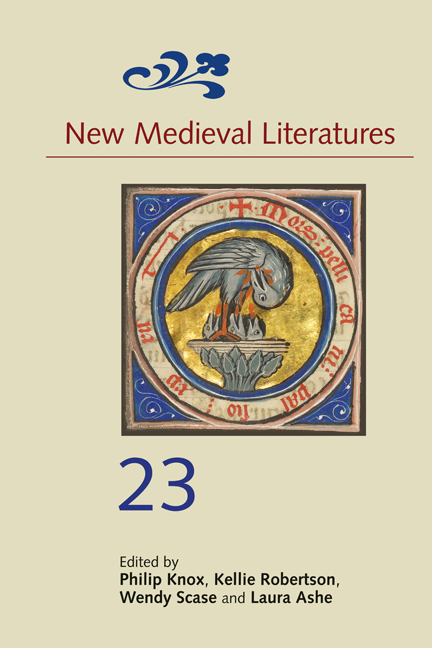Book contents
- Frontmatter
- Contents
- List of Illustrations
- Editors’ Note
- List of Abbreviations
- 1 A Paradox, (Un)Identified: Grendel’s Mother and the Lacanian Real
- 2 What Christ Might Say: Adapting the Last Judgment in the Prick of Conscience and Humbert’s De Dono Timoris
- 3 ‘At Jherusalem hyt ys goyd wyne’: The English Taste for the Sweet Blood of the Holy Land
- 4 The Bright Body: St Erkenwald’s Death Investigation
- 5 The Occasion of Chaucer’s Boece
- 6 ‘We axen leyser and espace’: Narrative Grace in Chaucer’s Franklin’s Tale and Melibee
- 7 The Shapes of the Speculum Christiani: Scribal Technique and Literary Aesthetics in Fifteenth-Century England
7 - The Shapes of the Speculum Christiani: Scribal Technique and Literary Aesthetics in Fifteenth-Century England
Published online by Cambridge University Press: 11 January 2024
- Frontmatter
- Contents
- List of Illustrations
- Editors’ Note
- List of Abbreviations
- 1 A Paradox, (Un)Identified: Grendel’s Mother and the Lacanian Real
- 2 What Christ Might Say: Adapting the Last Judgment in the Prick of Conscience and Humbert’s De Dono Timoris
- 3 ‘At Jherusalem hyt ys goyd wyne’: The English Taste for the Sweet Blood of the Holy Land
- 4 The Bright Body: St Erkenwald’s Death Investigation
- 5 The Occasion of Chaucer’s Boece
- 6 ‘We axen leyser and espace’: Narrative Grace in Chaucer’s Franklin’s Tale and Melibee
- 7 The Shapes of the Speculum Christiani: Scribal Technique and Literary Aesthetics in Fifteenth-Century England
Summary
Among the Middle English romances, saints’ lives, and comic exempla found in Oxford, Bodleian Library, Ashmole 61, its scribe copied an unassuming poem on the Ten Commandments: sixteen four-line stanzas in interlocking rhyme (abab), each stanza braced, somewhat clumsily, in text ink (fols 16v–17r). On folio 22v, the scribe – usually identified by the moniker ‘Rate’ – began to copy the poem again but realized his mistake and stopped after eight lines. Instead, on folios 22v and 23r, he copied a prayer to the Virgin Mary in rhyming couplets, also braced in text ink. Most likely, Rate found these poems in a manuscript of the Speculum Christiani: an earlier devotional work, mostly in Latin prose.3 He then isolated this material, versified and vernacular, from its Latinate and catechetical context. Insofar as he sought to produce a poetic anthology and not a devotional compilation, Rate read these versified texts not as catechetical tools but as poetry.
‘Poetry’ is not the rubric under which scholarship has treated the Speculum Christiani. It has, however, thoroughly documented its compi-lation and early transmission. Vincent Gillespie has shown in detail the intellectual and institutional circumstances that produced the Speculum and framed its immediate reception.4 Early in the fifteenth century, most likely in a Carthusian charterhouse in Lincolnshire or Nottinghamshire, a monk or group of monks composed the Cibus anime: a book of Latin prose that, employing a complex system of books and chapters, discusses the tenets of the Christian faith. Perhaps in a neighboring center, the Cibus anime was transformed into the Speculum Christiani: a manual for parish priests organized into a simpler division of eight sections or tabulae. The new work gained rapid popularity among priests associated with York Minster. In addition to this organizational overhaul, the compilers also added English verse and prose to the earlier work's Latin prose, among them the poems found in Ashmole 61. The Cibus anime itself may have sparked this transformation. Twelve rhyming tags in English are found in this otherwise Latinate text.
The combination of prose and verse, in English and in Latin – prevalent in works associated with pastoral reform in fifteenth-century England6 – foregrounds the aesthetic features of the work.
- Type
- Chapter
- Information
- New Medieval Literatures 23 , pp. 219 - 291Publisher: Boydell & BrewerPrint publication year: 2023



